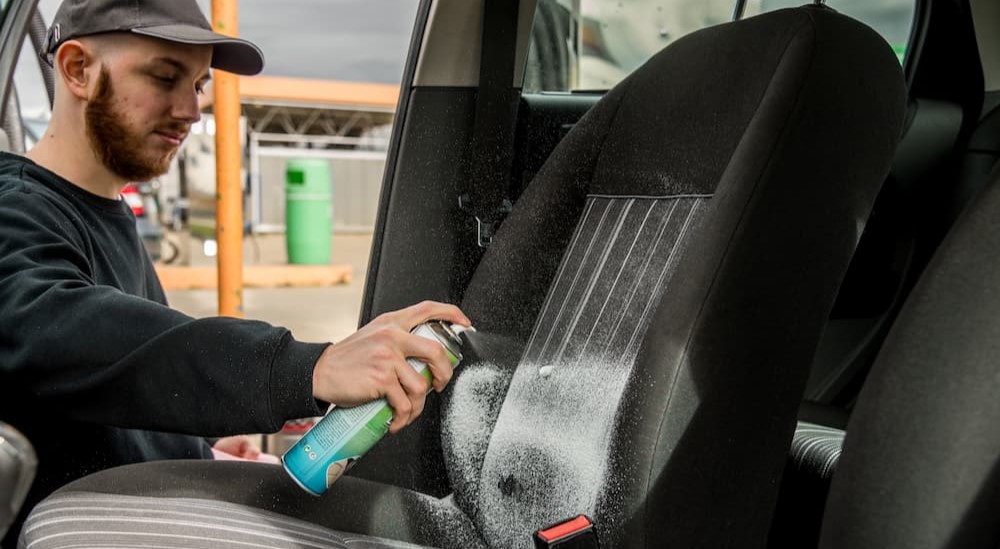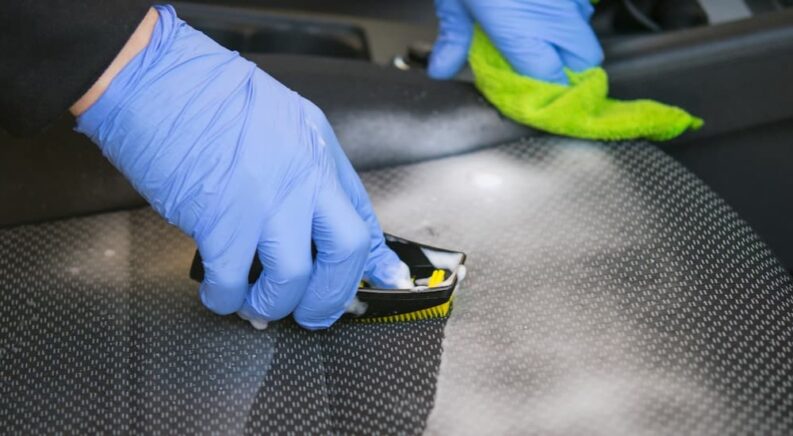From precariously piled ice cream cones and tubes of bright red lipstick to nail polish, crumbs, sticky soda, and more, your vehicle’s upholstery is under constant assault from a variety of unsightly antagonists that are all conspiring to leave their mark. There are some ways to reduce the likelihood of a potential spill, but aside from establishing a strict “no food in the car” rule or patting your passengers down for any contraband, stains are going to happen. Learning to rid your car of stains might not be the most important maintenance task you’ll encounter as a driver, but there’s no underestimating the importance of this skill. From reducing obnoxious odors to helping your vehicle maintain its resale value, a little time spent with a scrub brush and some common household ingredients can greatly impact your overall driving experience. We’ve compiled a few tips and tricks to help keep your car, truck, or SUV looking as good as new, so join us as we review some best practices when it comes to addressing stubborn stains and spills.
The Basics
Different types of upholstery require different techniques to remove stains. It’s important to be wary of oversaturating the upholstery when dealing with porous cloth seats. Introducing too much moisture into the equation can result in mold, mildew, and other issues that might worsen the situation. When dealing with non-porous leather and vinyl upholstery, avoid any stain removers containing bleach or hydrogen peroxide. While these products might remove a stain, they can also lead to unsightly discoloration. Any time you’re dealing with a stain on leather, you’ll also want to follow up with a leather conditioning product that’ll prevent the material from cracking, peeling, or otherwise deforming as it dries.
Before you tackle that stubborn stain or spill, it’s important to do a little prep work. Pre-cleaning the area using a stiff brush or breaking out the vacuum cleaner can help remove dirt, grime, crumbs, and other debris that might be lurking on your upholstery. It might seem like an easy step to skip, but if you launch into scrubbing or spraying the stain right away, you risk working these foreign materials deeper into the seating material. After you’ve removed the bulk of the debris from the seats, take one final pass with a microfiber cloth or a soft brush, and then launch into one of the techniques listed below.
Baking Soda
From baking a cake and removing odors to tackling tough stains and making the perfect volcano for your kid’s science fair project, baking soda has countless uses. Costing a grand total of $1.50 for a one-pound box, baking soda is probably one of the most cost-effective ways to give your upholstery a little refresh. Mix 1/4 cup of baking soda with some warm water until you achieve a paste with a consistency like cake icing. Find a fresh toothbrush, dab a healthy amount of the baking soda mixture onto the stain, and work it in with a circular motion. The stain should start to lift out after a few minutes of scrubbing. If you’re not having any luck, try letting the stain sit for up to 30 minutes. Once you’re done scrubbing, dab the area with a damp cloth and let it air dry.
Club Soda
If baking soda doesn’t do the trick, it might be time to raid your wet bar and grab a little club soda. It might be great for mixing up some of your favorite cocktails, but it also contains minerals like potassium citrate and potassium bicarbonate that have some compelling stain-fighting properties. Ideal for minor stains, club soda can be poured into a spray bottle, applied to the stain, and gently scrubbed into the upholstery. Follow up with a clean cloth, let the area dry, and you’ll be back to enjoying happy hour in no time.

Vinegar
Your kitchen might not seem like a well-stocked car detailing center, but there are a surprising number of common ingredients that can be called into service to remove stains. Vinegar is a great all-natural cleaner, and can even be used to address stains in your vehicle’s upholstery. Just add one cup of white vinegar to a gallon of water, add a small drop of dish soap, and start working it into the stain with a small brush. After the stain has faded away, hit the area with a little warm water to remove any soapy residue that could irritate your skin. Dab it with a microfiber cloth, then roll down your windows to let the area air dry.
Laundry Detergent
Laundry detergent isn’t just good for lifting stains out of your clothes. It can also work the same magic for your upholstery. Mix dry or liquid detergent with a little warm water, apply it to the stain with a brush, and let it soak in. When using laundry detergent or any soap, it’s important to not overdo it. It might work a treat for removing stains, but a heavy pour could compound your cleaning project as you struggle to remove the detergent itself. Hit the area with a cloth soaked in cold water and, if it’s still coming up soapy after a few passes, switch it out for a new cloth. Repeat until the stain and detergent residue is fully removed and enjoy your clean seats.
Nail Polish Remover
Some surfaces require special treatment, especially leather and vinyl upholstery. Whether you’re dealing with a stain that’s the result of a paint spill, dye, or a Sharpie-wielding kiddo, nail polish remover can be your best friend when trying to remove a spot. Dip a cotton ball in some nail polish remover or pure acetone and dab it on the stain. Make sure not to scrub the stain, as this could cause the damage to spread. After the stain has lifted, hit the area with a quick rinse of warm water, pat it dry, and you’re done.
Drivers should exercise caution when applying nail polish remover to their upholstery. Some products could cause bleaching and leave a discolored spot, so before addressing a stain, try testing the acetone on a less conspicuous area of the vehicle, like the bottom edge of your seat. If you’re worried about lasting damage, try using rubbing alcohol instead, as it tends to be a little easier on upholstery.
Ice
If you find yourself in a sticky situation that involves chewing gum or a melted chocolate bar, ice might be your best friend. Grab an ice pack or throw a couple of ice cubes into a plastic bag and hold it against the sticky spot until it starts to freeze and harden. This will make it easier to scrape off the gunk with a butter knife in one fell swoop, though you might need to take an additional pass with one of the other techniques mentioned on this list.

Upholstery Cleaner
If some common kitchen essentials fail you, it’s time to turn to commercial cleaning products. Specifically formulated for various types of upholstery including cloth, leather, and synthetic leather, these cleaning products offer solid results for a relatively small investment. Since different upholstery cleaners vary in their approach, we won’t get into the specifics when it comes to application. Just make sure to read the instructions on the bottle and don’t go overboard when dosing it out.
Steam Cleaning
A little steam can go a long way towards lifting some of the toughest stains you can encounter. Renting a steam cleaning machine or acquiring your own setup is no small investment, but there are few better ways of blasting stains, smells, mold, and mildew out of your vehicle’s fabric upholstery. A steam cleaner is also one of the quickest and easiest ways to tackle a stain. Most steam cleaners will both blast 245-degree steam into the fabric and suction it back out, allowing drivers to avoid the scrubbing, dabbing, and rinsing that comes with some of the other methods we’ve mentioned.
Keeping your vehicle clean will not only make for a more comfortable driving experience, but it can also have a noticeable impact on your vehicle’s resale value. While the state of the upholstery might not be at the top of the buyer’s list of concerns, an unkempt interior can be a red flag that indicates the vehicle wasn’t cared for, both mechanically and aesthetically, while it was in your possession. Remember, addressing a stain before it has time to set will almost always make cleanup a lot easier. It’s never a bad idea to keep a bottle of upholstery cleaner in your trunk for emergencies, but most of the ingredients you need to keep your interior spic-and-span can be found in your kitchen cupboard. From vinegar and club soda to baking soda and nail polish remover, common household goods are all you need to keep your vehicle looking like it just rolled off the factory floor.

